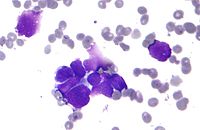
Photo from wikipedia
The clinical utilities of paclitaxel in anaplastic thyroid carcinoma (ATC) have been reported. The current study investigated the outcomes in ATC patients treated by paclitaxel as neoadjuvant setting. Furthermore, the… Click to show full abstract
The clinical utilities of paclitaxel in anaplastic thyroid carcinoma (ATC) have been reported. The current study investigated the outcomes in ATC patients treated by paclitaxel as neoadjuvant setting. Furthermore, the prognostic factor for overall survival (OS) and predictive marker for response to paclitaxel were investigated. Records of ATC patients treated by paclitaxel as neoadjuvant setting in our hospital were reviewed. The median OS for the patients with (n = 43) and without (n = 23) resection were 14.7 (95% CI, 11.0–21.7) and 4.2 (95% CI, 3.0–5.4) months, respectively (p < 0.001). Univariate analysis identified the factors of stage (p = 0.028), prognostic index (PI) ≥2 (p < 0.001), response to paclitaxel (p = 0.007), resection (p < 0.001), and radiotherapy (p < 0.001) to be associated with OS, and multivariate analysis revealed that the factors of PI ≥2 [hazard ratio (HR), 2.406 (95% CI, 1.096–5.281), p = 0.029], response to paclitaxel [HR, 0.423 (95% CI, 0.193–0.930), p = 0.032], resection [HR, 0.316 (95% CI, 0.129–0.773), p = 0.012], and radiotherapy [HR, 0.229 (95% CI, 0.100–0.526), p < 0.001] were independent prognostic factors of OS. There were no significant predictive factors for response to paclitaxel in baseline characteristics. PI ≥2, response to paclitaxel, resection, and radiotherapy were independent prognostic factors in ATC patients treated with paclitaxel as neoadjuvant setting. It is important to investigate predictor for response to paclitaxel for improving resectability and prognosis in ATC.
Journal Title: Cancer Medicine
Year Published: 2022
Link to full text (if available)
Share on Social Media: Sign Up to like & get
recommendations!